Common Eider Duck
- February 20, 2024
- 0 comment
The Common Eider Duck, scientifically known as Somateria mollissima, is a fascinating species that inhabits coastal regions of the northern hemisphere. Renowned for its striking appearance and soft down feathers, this large sea duck holds a significant place in both ecological and cultural contexts. With males displaying vibrant black and white plumage accented by pale green patches during breeding season, and females adorned in more subdued brown feathers, the Common Eider Duck exhibits pronounced sexual dimorphism.
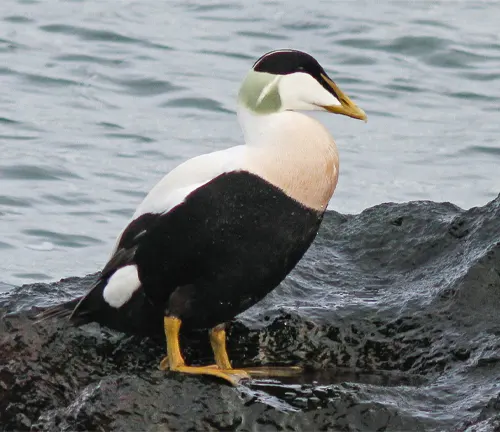
These ducks primarily inhabit rocky shorelines, estuaries, and offshore islands, where they form large colonies during the breeding season. Utilizing their specialized beaks, they dive to considerable depths in search of marine invertebrates and small fish, contributing to the balance of marine ecosystems. Despite facing threats such as habitat loss and hunting pressure, efforts to conserve the Common Eider Duck are underway, highlighting its importance in both natural and cultural landscapes.
| Specifications | Details |
|---|---|
| Scientific Name | Somateria mollissima |
| Common Name | Common Eider Duck |
| Family | Anatidae (ducks, geese, swans) |
| Size | 23 to 29 inches (58 to 74 cm) in length |
| Weight | 1.5 to 5 pounds (0.7 to 2.3 kg) |
| Plumage | Male: Black and white with pale green patches |
| Female: Subdued brown | |
| Habitat | Coastal regions, rocky shorelines, estuaries |
| Distribution | Northern hemisphere |
| Feeding Habits | Dive for marine invertebrates and small fish |
| Social Behavior | Gregarious, form large flocks |
| Conservation Status | Not endangered, faces threats from habitat loss |
| and hunting pressure | |
| Importance | Ecologically vital for marine ecosystems |
| Culturally significant in various communities |
Exploring the Fascinating World of the Common Eider Duck

The Common Eider Duck is a fascinating bird species that captures the attention of bird enthusiasts and nature lovers alike. With its distinctive appearance and interesting behaviors, this duck holds a significant place in the ecosystem. In this article, we’ll delve into the world of the Common Eider Duck, exploring its physical characteristics, habitat, behavior, conservation status, and more.
What is the Common Eider Duck?
The Common Eider Duck, scientifically known as Somateria mollissima, is a large sea duck native to the northern hemisphere. It belongs to the family Anatidae, which includes ducks, geese, and swans. Renowned for its soft down feathers, the Common Eider Duck is highly valued for its eiderdown, which is used in bedding and clothing.
Importance of the Common Eider Duck
Beyond its economic significance, the Common Eider Duck plays a vital role in coastal ecosystems. As a keystone species, it helps maintain the balance of marine food webs by controlling populations of invertebrates and small fish. Additionally, these ducks contribute to nutrient cycling through their feeding habits.
Physical Characteristics
Size and Weight
Common Eider Ducks are among the largest ducks, with males (drakes) typically being larger than females (hens). On average, drakes measure around 23 to 29 inches (58 to 74 cm) in length and weigh between 1.5 to 5 pounds (0.7 to 2.3 kg). In comparison, females are slightly smaller in size and weight.
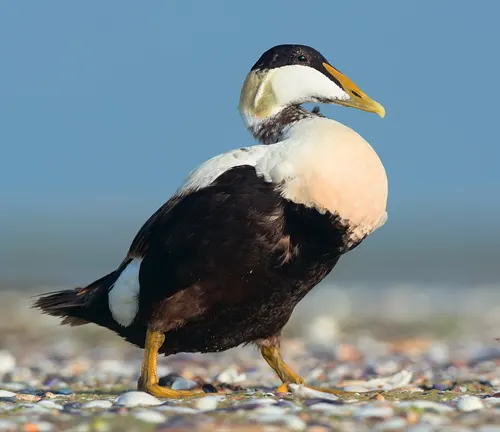

Plumage
The plumage of Common Eider Ducks varies between males and females and also changes during different seasons. During the breeding season, male ducks exhibit striking black and white plumage with pale green patches on their necks. This coloration serves as a display during courtship rituals. In contrast, females have more subdued brown plumage, providing camouflage while nesting. Outside of the breeding season, both males and females may molt into a less vibrant plumage for camouflage and protection.
Sexual Dimorphism
Sexual dimorphism is pronounced in Common Eider Ducks, with males displaying brighter colors and larger size compared to females. This difference in appearance is most evident during the breeding season when males compete for mates and establish dominance. The striking plumage of male ducks serves as a visual display to attract females and deter rival males.
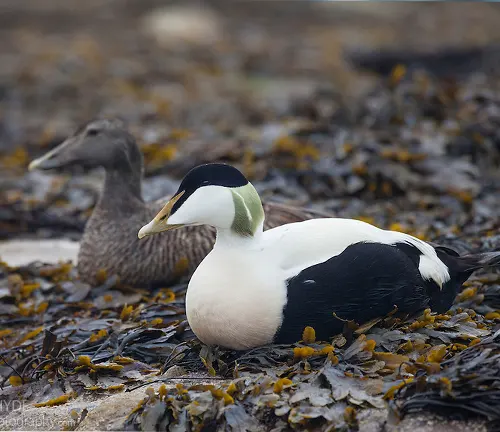
Habitat and Distribution
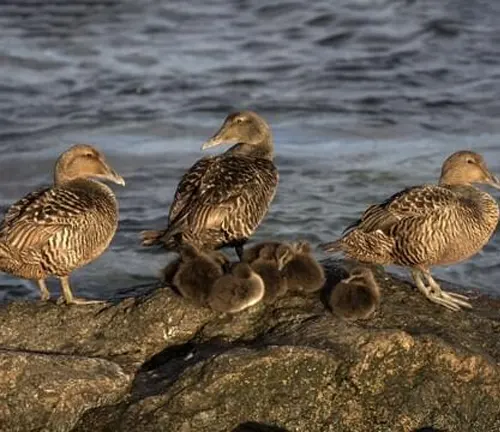
Coastal Habitats
Common Eider Ducks are primarily found in coastal habitats, including rocky shorelines, estuaries, and offshore islands. These ducks are well-adapted to marine environments and rely on coastal areas for feeding, nesting, and resting. Coastal habitats provide a rich and diverse array of food sources for Common Eider Ducks, including marine invertebrates and small fish.
Breeding Grounds
During the breeding season, Common Eider Ducks congregate in large colonies on remote islands or coastal cliffs. These breeding grounds offer protection from terrestrial predators and provide access to suitable nesting sites. Common Eider Ducks typically build their nests on the ground or among rocks, using vegetation and other materials to create a sheltered environment for their eggs. Breeding colonies are essential for the reproductive success of Common Eider Ducks, providing a safe and secure environment for raising their young.
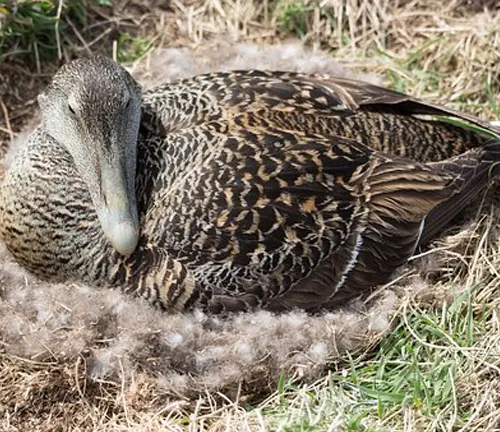

Migration Patterns
Like many migratory birds, Common Eider Ducks undertake long-distance migrations between their breeding and wintering grounds. They travel southward to warmer waters during the winter months, often forming large flocks along their migratory routes. Migration allows Common Eider Ducks to access food resources and escape harsh weather conditions in their breeding areas. These birds rely on coastal habitats along their migration routes for resting and refueling before continuing their journey.
Behavior and Diet
Feeding Habits
Common Eider Ducks are primarily diving ducks, known for their adeptness at diving to forage for food underwater. They feed on a variety of marine invertebrates such as mollusks, crustaceans, and echinoderms, as well as small fish. Using their specialized beaks, Common Eider Ducks dive to considerable depths in search of prey, often staying submerged for extended periods. Their feeding habits play a crucial role in maintaining the balance of marine ecosystems, as they help control populations of prey species.
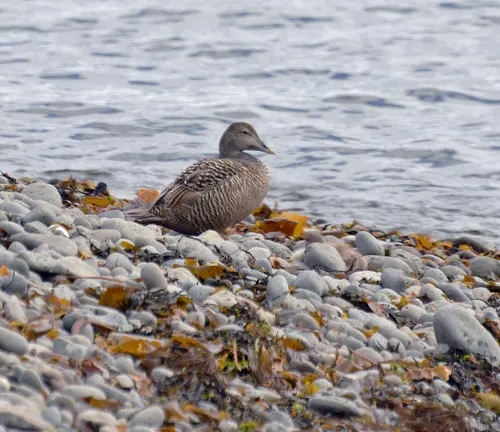
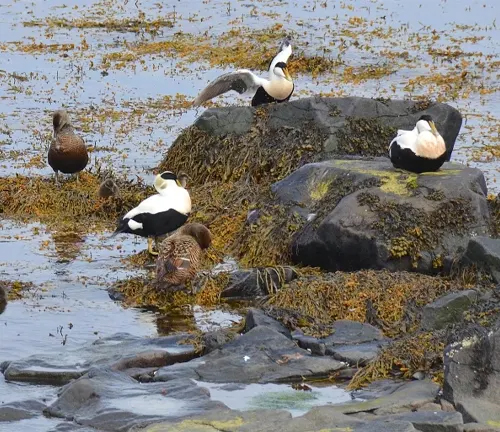
Social Behavior
Common Eider Ducks are generally gregarious birds, often forming large flocks, especially during migration and wintering periods. Within these flocks, individuals engage in various social behaviors, including courtship displays, vocalizations, and cooperative feeding. Social interactions play an important role in the communication and bonding among members of the flock, contributing to the overall cohesion and well-being of the group.
Nesting Behavior
During the breeding season, Common Eider Ducks build their nests in sheltered locations, typically on the ground or among rocks. Females lay a clutch of eggs, which they then incubate until they hatch. The nesting sites are carefully chosen to provide protection from predators and environmental elements. Common Eider Ducks use materials such as vegetation, feathers, and other debris to construct their nests, creating a cozy and secure environment for their eggs and young ducklings.
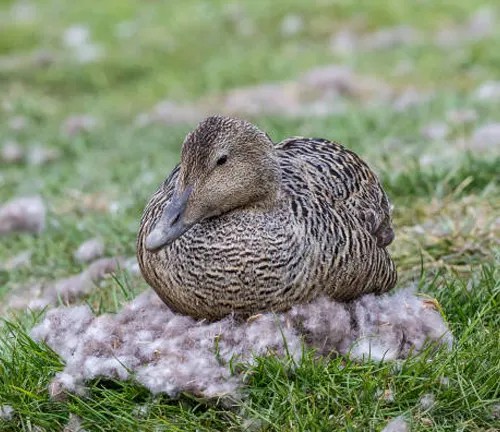
Conservation Status
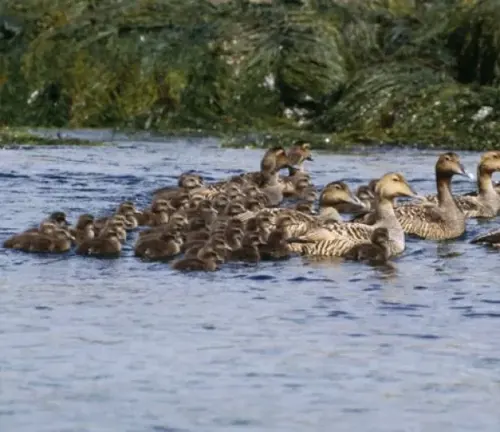
Threats
Common Eider Ducks face various threats to their survival and well-being. These threats include habitat loss and degradation due to coastal development, pollution of marine environments from industrial activities and oil spills, predation by introduced species such as rats and foxes on breeding islands, disturbance at breeding sites caused by human activities, and overharvesting through hunting. Additionally, climate change poses a significant threat to Common Eider Ducks, affecting their breeding success, food availability, and overall habitat suitability.
Conservation Efforts
Efforts to conserve Common Eider Ducks and their habitats are essential for ensuring the long-term viability of this species. Conservation initiatives include habitat restoration projects aimed at preserving and enhancing coastal habitats, monitoring and protection of breeding colonies to reduce disturbance and predation, regulation of hunting activities to ensure sustainable harvest levels, and raising awareness about the importance of Common Eider Ducks in marine ecosystems. Collaborative conservation efforts involving government agencies, conservation organizations, researchers, and local communities are crucial for the effective management and conservation of Common Eider Ducks and their habitats.
Interaction with Humans
Hunting
Common Eider Ducks have been hunted for centuries for their meat, feathers, and down. While regulated hunting can be sustainable and provide a source of food and income for local communities, overexploitation and illegal poaching pose significant threats to their populations. Hunting pressure, particularly during the breeding season, can disrupt nesting colonies and lead to population declines. Conservation measures, such as implementing hunting regulations, establishing protected areas, and promoting sustainable hunting practices, are essential for maintaining healthy populations of Common Eider Ducks.
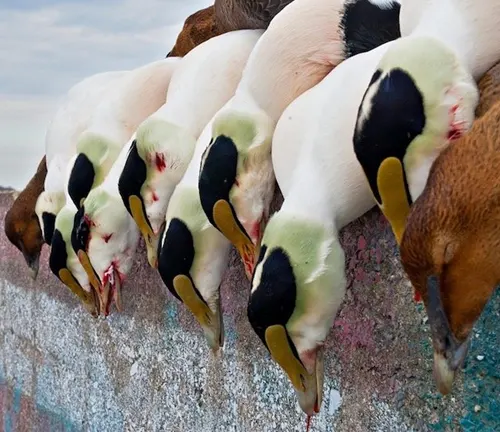
Cultural Significance
In addition to their ecological importance, Common Eider Ducks hold cultural significance in various indigenous communities and coastal cultures around the world. They feature prominently in folklore, art, and traditional practices, symbolizing resilience, adaptability, and a deep connection to the marine environment. Common Eider Ducks are often revered for their beauty, grace, and importance in sustaining coastal communities through their contributions to food security and cultural identity. Their presence in cultural ceremonies, rituals, and storytelling reflects the enduring relationship between humans and nature, highlighting the intricate web of connections that shape our shared heritage.
Different Species
Pacific Eider
(Somateria mollissima v-nigrum)
Found along the Pacific coast of North America, this subspecies is distinguished by its darker plumage and white “V” mark on the back of the neck of the male.
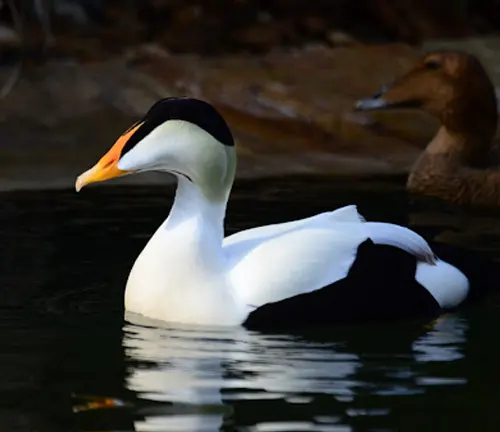

American Eider
(Somateria mollissima dresseri)
Inhabiting the Atlantic coast of North America, the American Eider is characterized by its large size and distinctive coloration, similar to other Common Eider subspecies.
Northern Eider
(Somateria mollissima borealis)
Found in the northern parts of Europe and Asia, this subspecies exhibits typical Common Eider characteristics and is well-adapted to cold climates.
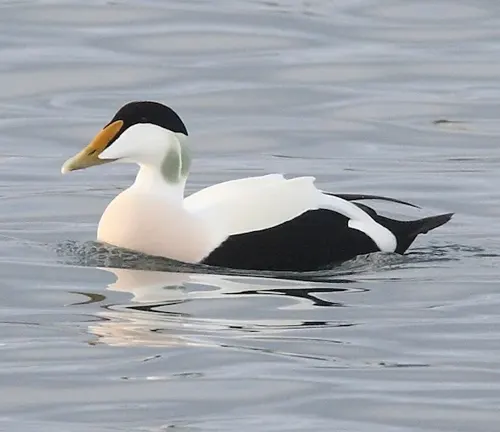
Frequently Asked Questions (FAQs)
- Are Common Eider Ducks endangered?
Common Eider Ducks are not currently classified as endangered. However, they face conservation concerns due to habitat loss, hunting pressure, and other human-induced threats. - Where are Common Eider Ducks found?
Common Eider Ducks are primarily found in coastal regions of the northern hemisphere, including North America, Europe, and parts of Asia. - What do Common Eider Ducks eat?
Common Eider Ducks primarily feed on marine invertebrates such as mollusks, crustaceans, and echinoderms. They also consume small fish and sometimes algae. - How do Common Eider Ducks reproduce?
Common Eider Ducks typically breed in colonies located in coastal areas. Females lay eggs in nests constructed on the ground or among rocks. After hatching, ducklings are cared for by the female. - Do Common Eider Ducks migrate?
Yes, Common Eider Ducks are migratory birds. They undertake long-distance migrations between breeding and wintering grounds, often congregating in large flocks during migration. - What is the lifespan of a Common Eider Duck?
The lifespan of a Common Eider Duck is typically around 10 to 15 years in the wild, although some individuals may live longer under favorable conditions. - How do Common Eider Ducks protect themselves from predators?
Common Eider Ducks rely on several strategies to protect themselves from predators, including camouflage, vigilant behavior, and seeking refuge in inaccessible areas such as rocky shores and offshore islands. - What is the significance of the eiderdown produced by Common Eider Ducks?
Eiderdown refers to the soft feathers of Common Eider Ducks, which are highly valued for their insulating properties. Eiderdown is used to fill pillows and bedding, providing warmth and comfort. - Are Common Eider Ducks social birds?
Yes, Common Eider Ducks are social birds, often forming large flocks, especially during migration and wintering periods. They engage in various social behaviors such as courtship displays and vocalizations. - Do Common Eider Ducks have any natural predators?
Common Eider Ducks face predation from various species, including birds of prey such as eagles and falcons, mammals like foxes and mink, and larger birds such as gulls and ravens. - How do Common Eider Ducks communicate with each other?
Common Eider Ducks communicate through a variety of vocalizations, including quacks, grunts, and whistles. They also use body language and visual displays to convey information to other ducks. - What is the role of Common Eider Ducks in their ecosystem?
Common Eider Ducks play a crucial role in coastal ecosystems by regulating populations of prey species and contributing to nutrient cycling through their feeding habits. - Are there any conservation efforts in place to protect Common Eider Ducks?
Yes, conservation efforts aimed at protecting Common Eider Ducks include habitat preservation, monitoring of breeding colonies, and regulation of hunting activities to ensure sustainable populations. - What is the difference between male and female Common Eider Ducks?
Male Common Eider Ducks, known as drakes, typically have striking black and white plumage with pale green patches on their necks during breeding season, while females, known as hens, have more subdued brown plumage. - Can Common Eider Ducks fly long distances?
Yes, Common Eider Ducks are capable of flying long distances during migration between their breeding and wintering grounds, utilizing their strong wings for propulsion.


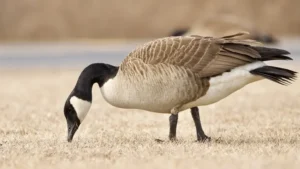
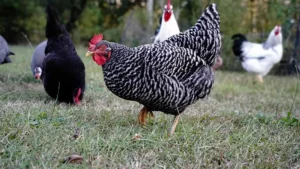
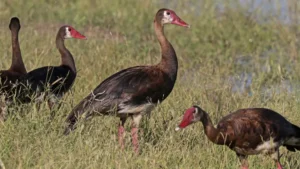
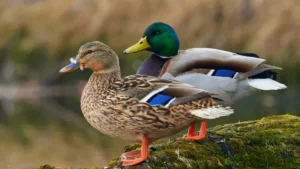
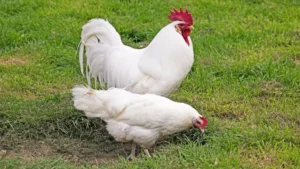
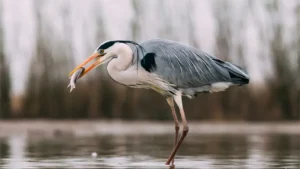


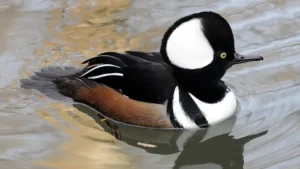


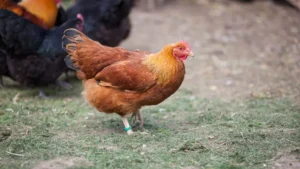
Leave your comment